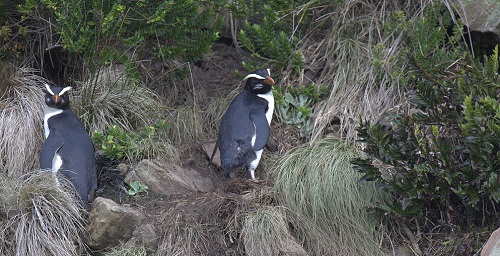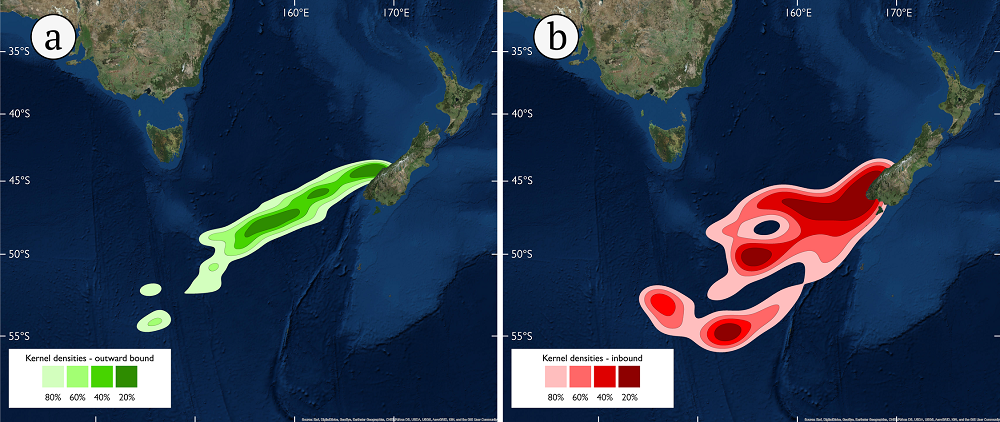← Back
New Zealand’s Marathon Penguins

New Zealand is home to more penguin species than any other country in the world. The Tawaki penguin, also known as the Fiorland penguin (Eudyptes pachyrhynchus), is one such species that breeds on the New Zealand mainland. With an estimated population size of merely 5,500–7,000 mature birds, Tawaki are very rare, and are classified under the IUCN Red List criteria as ‘Vulnerable.’ Curious about the reasons leading to population decline, and interested in the long-range dispersal of these birds, Dr. Klemens Pütz of the Antarctic Research Trust and Dr. Thomas Mattern from the University of Otago teamed up and attached Argos transmitters to adult Tawaki penguins between the end of their breeding season and the annual moult in order to track their movements at sea. The article “Marathon penguins – Reasons and consequences of long-range dispersal in Fiordland penguins / Tawaki during the pre-moult period” (Plos One) of which an adaptation the abstract is published below, sheds light on the environmental properties at Tawakis’ trip destinations and explores the biogeographical implications of their long distance travel.
Learning more about Tawaki penguins’ marathon travel
Migratory species often roam vast distances bringing them into contact with diverse conditions and threats that could play significant roles in their population dynamics. This is especially true if long-range travels occur within crucial stages of a species’ annual life-cycle. Crested penguins, for example, usually disperse over several hundreds of kilometres after completing the energetically demanding breeding season and in preparation for the costly annual moult. A basic understanding of crested penguins’ pre-moult dispersal is therefore paramount in order to be able to assess factors affecting individual survival.
Argos tracking reveals long journeys
Dr Thomas Mattern and his team successfully Argos satellite tracked the pre-moult dispersal of 17 adult Tawaki from a single colony located in the species’ northern breeding distribution. Over the course of 8–10 weeks the penguins travelled up to 2,500 km away from their breeding colony, covering total swimming distances of up to 6,800 km.
During outbound travels all penguins headed south-west within a well-defined corridor before branching out towards two general trip destinations. Birds leaving in late November travelled towards the Subtropical Front some 800 km south of Tasmania, whereas penguins that left in December headed further towards the subantarctic front.
More info about marine animals tracking
Impact of oceanographic conditions
Using K-select analysis the team examined the influence of oceanographic factors on the penguins’ dispersal. Water depth, surface current velocity and sea level anomalies had the greatest influence on penguin movements at the subantarctic Front, while sea surface temperature and chlorophyll a concentration were key for birds travelling to the subtropical front.
Read the full article in Plos One “Marathon penguins – Reasons and consequences of long-range dispersal in Fiordland penguins / Tawaki during the pre-moult period”, to find out more about what Dr Mattern and his co-authors discovered in light of anthropogenic activities (or lack thereof) in the regions visited by the penguins as well as the potential consequences of Tawaki pre-moult dispersal for the species’ breeding distribution on the New Zealand mainland.
Key findings about Tawaki’s journeys
Daily travel distances indicate a steady increase during the first third of the penguins’ journey from about 20 km per day to an average 50 km per day. During the second third, distances travelled per day remained between 40 and 60 km per day, before the penguins increased their daily travel quota steadily to cover an average 80 km or more per day towards the end of their journeys.
Figure 1: Kernel densities of Tawaki positions during the outward-bound portion of their pre-moult journey (A) and their inbound journey (B). Read the full article for details on methods used.
Longest trip
The longest trip recorded by this study was a round-trip journey to the Subantarctic Front undertaken by a female Tawaki penguin over 67 days. She swam 83 km/day on average for a total distance of 6,801 km. An amazing distance for an animal whose weight was only 2.95 kg when she began her voyage.
About the study
This important work was funded in part by the Antarctic Research Trust, who covered costs for Argos Devices and data acquisition. Additional funding was provided by the Global Penguin Society, Ornithological Society New Zealand (Birds NZ Research grant), the JS Watson Trust and Forest & Bird Southland. Data are available through the Movebank Animal Tracking Database (movebank.org, Movebank Study ID: 302410815).
About Dr. Klemens Pütz
Since 1998 Dr. Pütz has deployed nearly 300 sat tags on Kings, Southern Rockhoppers, Erect-crested, Gentoo, Magellanic, Humboldt and Yellow-eyed Penguins. This was often done autonomously (in the Falklands) but also in cooperation with Dr. Andrea Ray Rey (CADIC-CONICET Ushuaia Argentina) Prof. Alejandro Simeone (Andres Bello University Santiago Chile) and Dr. Thomas Mattern (Tawaki-Project, Dunedin New Zealand).
In addition, he has cooperated with Dr. Richard Philips (BAS) tracking juvenile Black-browed and Wandering Albatrosses, and with Dr. Julieta Pedrana (INTA Balcarce Argentina) tracking sheldgeese in South America (program 5526).
Citation: Mattern T, Pütz K, Garcia-Borboroglu P, Ellenberg U, Houston DM, Long R, et al. (2018) Marathon penguins – Reasons and consequences of long-range dispersal in Fiordland penguins / Tawaki during the pre-moult period. PLoS ONE 13(8): e0198688. https://doi.org/10.1371/journal.pone.0198688
Photo of Fiordland penguins courtesy of Wikimedia, travelwayoflife.


